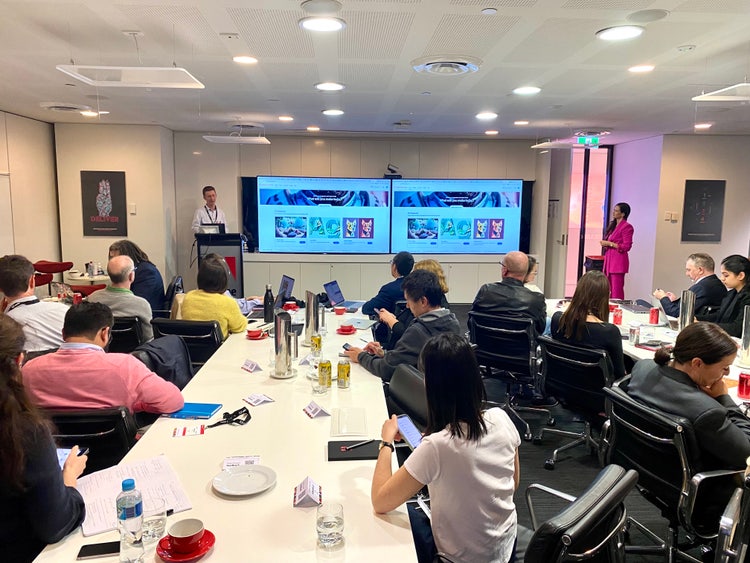Embracing generative AI in higher education

Generative AI is changing how people create, and young tech-savvy students are some of the first to push the technology to its limits. The big question for educators is how to help students unleash their creativity while balancing this innovation with ethical responsibility.
At a recent Higher Education Executive Roundtable in Australia, leaders from the country’s top educational institutions got together to discuss generative AI in higher education. How will it transform curriculum? Do student assessments need to change? What does generative AI offer to enhance digital fluency and prepare students to become communicators and future leaders?

Professor Sid Dobrin, chair and professor of English at the University of Florida, is known worldwide as a respected leader in AI and academia. He kicked off the discussion by sharing research and insights from his work around using generative AI with students. Professor Sherman Young, deputy Vice-Chancellor (Education) and VP of RMIT University, an Adobe Creative Campus, shared RMIT’s innovative strategies and policies around AI and other new technologies. Finally, professor Gabriele Suder, associate deputy Vice-Chancellor Academic of Federation University, drew upon her business experience to showcase how AI can help students solve real business problems.
Student representatives joined in, offering perspectives on how AI can benefit today’s learners. The active discussion was followed by a sample classroom exercise in Adobe Photoshop using Adobe Firefly, the new creative generative AI model from Adobe. Features such as Text to Image, Generative Fill, Text Effects, and Generative Recolor offer ways for students to realize their creative vision and iterate quickly on ideas.
Here are some key takeaways
Embrace authentic assessments
A big concern about generative AI in education is that students may use it as an unethical shortcut. The group discussed how rethinking assessments can combat this behavior. Rather than assigning a written report, ask students to analyze information and communicate their ideas through a compelling video, podcast, or infographic.
“We need to embed AI literacy into courses,” says Rowena Ulbrick, Academic director — Digital Literacies at Swinburne University. “Creating opportunities and authentic learning experiences, such as solving real-world problems, will ensure that students can demonstrate skills and use generative AI in ways that enhance learning.”
Generative AI’s role in classrooms
It’s no secret educators worry about tools like ChatGPT. While the first instinct for many is to keep it away from classrooms, a more realistic approach is to find ways to embrace it. Generative AI is gaining a foothold in every industry. Students need to understand how it works and how it can be used in a positive, agile, and ethical way.
“Companies in all industries need employees who can use emerging technologies such as generative AI to be more productive and produce better work,” says professor Angela Carbone, associate deputy Vice-Chancellor Learning & Teaching STEM at RMIT University. “It’s our job as educators to help students not only develop their skills, but also understand how to engage with technologies in a more responsible, ethical, and effective ways.”
Listen to student voices
A highlight of the roundtable was listening to student voices. The discussions revealed a disconnect between higher education and younger generations. Students put minimum effort into rote assignments that they feel won’t help them in future careers. Creative assignments encourage students to work harder. They also enhance learning outcomes and enable teachers to better assess student capabilities.
Holly Harper, a student at Federation University, explains, “Students want to feel a sense of ownership over their assessments and not just like they’re recreating something. In my programming classes, people don’t like assignments where they have to write specific code and try to get the ‘right’ answer. Instead, we want assignments that challenge us to do something like create a short game where we can choose our goals.”

Think creatively to support learning
As educators bring generative AI into classrooms, they should look for ways to use the technology to help students think both creatively and critically.
Ulbrick suggested that educators focus on generative AI’s ability to accelerate creative ideation. “By using the Adobe Firefly capabilities as part of the creative workflow, students can iterate on ideas and communicate them more effectively,” she says. “We don’t want algorithms to dictate what student creativity looks like, but we can teach students how to effectively use the tools to build upon their ideas.”
Carbone shared examples of how professors at RMIT use generative AI to develop new types of academic assessments that explore the potential and limits of the technology. One engineering professor employed ChatGPT as a brainstorming partner that helped students find inspiration for a research assignment. In another classroom, a health science lecturer found a unique way of teaching students about the benefits and drawbacks of working with generative AI.
“The lecturer asked students to write an essay and then prompt ChatGPT to write an essay on the same topic,” says Carbone. “Then the students compared the output to see the difference and gain a stronger understanding of the impacts of using AI in health sciences. This insight — and the process of critically assessing AI-generated content — advances digital literacy. It’s something students need in any career.”
Some academics have been early adopters of generative AI and have been using it for their own learning and work. “I’m a very contextual learner, so if I’m studying something new, I might ask ChatGPT to tell me about it,” explains Harper. “I can prompt it to expand on different aspects of the information, or ask follow-up questions. Trying to see things from different perspectives gives me a better understanding of the topic.”
Whether talking to students or educators, roundtable attendees appreciated how the lively discussions helped them rethink the possibilities of generative AI in education.
“It was valuable to connect with peers and hear what other institutions are doing,” says Carbone. “I was particularly interested in how others handle developing digital fluency so students become ethical digital citizens.”
“I really enjoyed seeing educators getting so passionate about authentic assessments,” adds Harper. “It’s exciting to hear that educators are ready to try new things to give students like me with the skills we need for the future.”